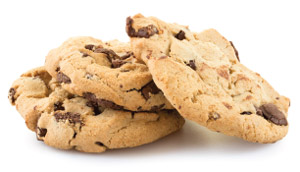Tips to reduce sugar in baking
This article was originally published in December 2016

“Can I reduce the sugar in recipes for baked goods?”
It’s a question we’ve heard more from shoppers as research about the negative health effects of too much sugar have started to mount.
So we looked for expert advice from cookbook authors and our own PCC Cooks instructors. The verdict?
Sugar can be reduced by about a third without seeing many negative consequences, although the difference will be noticeable. When you reduce by more than that in traditional recipes, you’ll have problems. Baker and cookbook author Alice Medrich says that while you can reduce sugar by as much as 25 or 33 percent, you may want to try cutting sugar by 10 or 15 percent first then gradually continue reducing more.
When it’s ok to cut sugar:
- Pies, custards, compotes, galettes, or any treat where sugar is only for sweetness and not for any chemical reaction. The filling for pies and galettes after baking may be a bit drier than usual because as sugar melts, it turns into a kind of moisture and it helps coax the natural juices out of the fruit. Note: Make sure the fruit is ripe and sweet!
- Quick breads because the loaves freeze well, so shelf life and moisture aren’t considerations.
- Cakes, cake-y cookies and no-bake bars. They won’t last as long, but if you’re eating cake the day you bake it, you can reduce sugar sometimes as much as two-thirds and still have wonderful results, says chef Joanne Chang, author of “Baking with Less Sugar.”
Special notes and exceptions
- Cookies with buttery, caramelized, snappy edges or fudgy, chewy centers don’t work well if sugar is reduced because the texture comes from the ratio of fat to sugar.
- Cookies that are meant to be dry and crunchy such as biscotti should be baked extra thin if you reduce sugar so they’ll be crispy instead of hard and tough, Medrich advises.
- Fruit with tart skins or bitter seeds, such as plums or blackberries, tend to taste a little more sour after they’re cooked, so adjust sugar before cooking accordingly.
- No-bake bars are good candidates for reducing sugar, unless the recipe relies on the stability of starch provided by confectioners’ sugar. In that case, you can try to make up the volume lost by swapping in very finely ground graham crackers or cornstarch.
Sugar substitutes
- Add in naturally sweet spices such as cinnamon, cardamom, nutmeg and allspice to make up for some loss of sweetness.
- Substituting fruit for sugar works in some recipes, especially quick breads and cakes. Either add it as a whole, fresh fruit (applesauce, mashed banana) or as juice (apple, cranberry, grape). Because fruit adds such a distinctive flavor to pastries, use it only when it will complement the other ingredients. For example, use crushed pineapple or apple juice in carrot cake, says Chang.
- Look to bonappetit.com for pros, cons and other tips for substituting alternative sweeteners. “I encourage students to use different sugars such as brown, demarara, unbleached granulated, raw, maple syrup, honey, etc., because you get more bang for your buck,” says PCC Cooks instructor Laurie Pfalzer. These sugars have way more flavor and complement the baked good, so it’s easier to use less.”
Sugar’s many purposes
Sweetness is the least of your challenges when reducing sugar — our palates adjust surprisingly well to less sugar. It’s the other issues that arise that you need to be aware of: moistness, keeping quality, color, lack of crispness. But if you prime your palate for these adjustments, you can enjoy pastries with less sugar and not miss it at all. — Chef Joanne Chang
Tenderizing
Reducing sugar can make a product tougher. For cookies this might not matter but for sweetened breads, reducing sugar could yield a hard, unpleasant result.
Liquefying
Sugar is a liquefier. Baking ingredients are made up of liquefiers and stabilizers. “If you remove one or cut it back, you need to replace it with a similar ingredient or suffer the consequences,” says Pfalzer. For instance, you can’t substitute a cup of fruit juice for a cup of sugar.
Spreading
The amount of sugar directly relates to how much a given item will “spread” when baked. As a general rule, more sugar means more spread.
Moisture and shelf life
The more sugar in the recipe, the softer and moister the baked good is and the longer it maintains freshness. If you reduce sugar, check for doneness earlier than usual.
Browning
Sugar contributes to browning via caramelization. In many cases, it may not matter if the baked good is a little pale. In others (bread, for example), it could mean your loaf won’t brown properly.
Fermentation aid
Reducing added sugar in a yeast-risen recipe can seriously affect fermentation, inhibiting proper rise before or during baking.
Aeration
Granulated sugars can combine with eggs, egg whites, egg yolks or fats to aerate a mixture evenly. This is the base structure for many baked goods and reducing sugar can mean the batter or dough won’t have a solid foundation. Aeration also can be responsible for producing volume and/or ensuring an even crumb.
— Adapted from Food52
